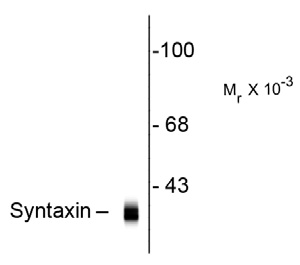Syntaxin 1A Antibody
Mouse monoclonal antibody
- SPECIFICATION
- CITATIONS
- PROTOCOLS
- BACKGROUND

Application
| WB |
|---|---|
| Primary Accession | Q16623 |
| Reactivity | Human, Hamster, Pig, Rat |
| Host | Mouse |
| Clonality | monoclonal |
| Isotype | IgG1 |
| Clone Names | SP8 |
| Calculated MW | 36 KDa |
| Gene ID | 6804 |
|---|---|
| Gene Name | STX1A |
| Other Names | Syntaxin-1A, Neuron-specific antigen HPC-1, STX1A, STX1 |
| Target/Specificity | Synaptic immunoprecipitate (crude) from human brain. |
| Dilution | WB~~ 1:1000 |
| Format | Protein G purified culture supernatant. |
| Antibody Specificity | The antibody is specific for the ~ 36 kDa syntaxin protein in Westernblots of rat brain lysate. The antibody has also been used for immunohistochemistry on formalinfixed, vibratome sections. Does not work on paraffin sections. |
| Storage | Maintain refrigerated at 2-8°C for up to 6 months. For long term storage store at -20°C in small aliquots to prevent freeze-thaw cycles. |
| Precautions | Syntaxin 1A Antibody is for research use only and not for use in diagnostic or therapeutic procedures. |
| Shipping | Blue Ice |

Thousands of laboratories across the world have published research that depended on the performance of antibodies from Abcepta to advance their research. Check out links to articles that cite our products in major peer-reviewed journals, organized by research category.
info@abcepta.com, and receive a free "I Love Antibodies" mug.
Provided below are standard protocols that you may find useful for product applications.
Background
Syntaxins are a family of proteins involved in the docking of synaptic vesicles with the plasma membrane. Syntaxin, along with synaptobrevin and SNAP-25, forms the SNARE complex which mediates synaptic vesicle fusion and exocytosis. Binding of Munc18-1 to the N-terminus of syntaxin 1 has been demonstrated to be essential for exocytic membrane fusion (Khvotchev et al., 2007). Decreased levels of phosphorylated syntaxin 1 in the prefrontal cortex have recently been correlated with schizophrenia (Castillo et al., 2010).
References
Khvotchev M
,
Dulubova I
,
Sun J
,
Dai H
,
Rizo J
,
Südhof TC
(2007) Dual modes of Munc18-
1/SNARE interactions are coupled by functionally critical binding to syntaxin-1 N terminus.
J
Neurosci.
2007 Nov 7;27(45):12147-55
Castillo MA
,
Ghose S
,
Tamminga CA
,
Ulery-Reynolds PG
(2010) Deficits in syntaxin 1
phosphorylation in schizophrenia prefrontal cortex.
Biol Psychiatry.
67(3):208-16
Honer, W. G., Hu, L. & Davies, P. Human synaptic proteins with a heterogeneous distribution in
cerebellum and visual cortex.
Brain Research
609, 9-20 (1993).
If you have used an Abcepta product and would like to share how it has performed, please click on the "Submit Review" button and provide the requested information. Our staff will examine and post your review and contact you if needed.
If you have any additional inquiries please email technical services at tech@abcepta.com.













 Foundational characteristics of cancer include proliferation, angiogenesis, migration, evasion of apoptosis, and cellular immortality. Find key markers for these cellular processes and antibodies to detect them.
Foundational characteristics of cancer include proliferation, angiogenesis, migration, evasion of apoptosis, and cellular immortality. Find key markers for these cellular processes and antibodies to detect them. The SUMOplot™ Analysis Program predicts and scores sumoylation sites in your protein. SUMOylation is a post-translational modification involved in various cellular processes, such as nuclear-cytosolic transport, transcriptional regulation, apoptosis, protein stability, response to stress, and progression through the cell cycle.
The SUMOplot™ Analysis Program predicts and scores sumoylation sites in your protein. SUMOylation is a post-translational modification involved in various cellular processes, such as nuclear-cytosolic transport, transcriptional regulation, apoptosis, protein stability, response to stress, and progression through the cell cycle. The Autophagy Receptor Motif Plotter predicts and scores autophagy receptor binding sites in your protein. Identifying proteins connected to this pathway is critical to understanding the role of autophagy in physiological as well as pathological processes such as development, differentiation, neurodegenerative diseases, stress, infection, and cancer.
The Autophagy Receptor Motif Plotter predicts and scores autophagy receptor binding sites in your protein. Identifying proteins connected to this pathway is critical to understanding the role of autophagy in physiological as well as pathological processes such as development, differentiation, neurodegenerative diseases, stress, infection, and cancer.


